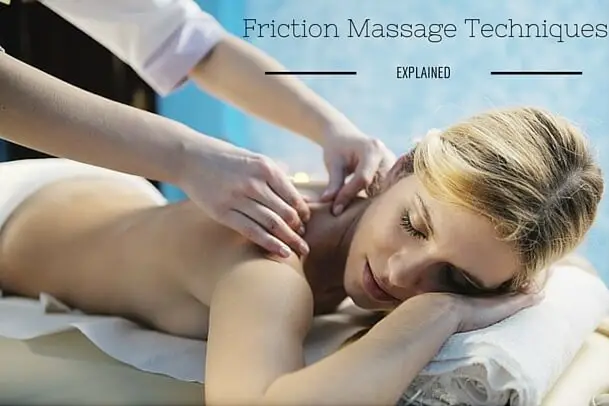Friction massage techniques are used on the body to work the soft tissues structures. Strengthening tendons, ligaments, and muscles. Friction massage is a deep and firm series of techniques, and can be used to work out injuries and knots in the muscle tissues.
Because the friction strokes are typically used on a small area of the body, oils are rarely used. The therapist will use their fingers to deliver the necessary pressure and work deep into the tissue to resolve the muscle pain.
Most therapists will use two different motions; transverse and circular. With transverse friction, the therapist relies on the tips of their fingers to dig deep into the tissue. The hands do not make long strokes as you would expect from a massage. More so just a pressing and pressure motion.
With the circular friction motions, the first two fingers and thumb are used to make circular motions. This is a very effective way to break and loosen up any adhesions. While giving a relaxing and deep massage, albeit a little uncomfortable sometimes.
The word ‘friction’ is taken from the Latin word frictio which means ‘to rub’.
Contents
What to Expect from a Friction Massage
Friction massage has a distinctive feel. If you have had massages before, like a Swedish massage you’re going to find a friction session very different. The therapist will focus on a small area of muscle, or a tendon. So it can be painful, but the result is very satisfying.
It starts with firm pressure being applied with the forefingers and thumb. This is not to be confused with unnecessarily hard pressure. Which is where the experience of a qualified therapist comes in. It’s not easy to judge how much pressure you need to apply if you’re self-massaging.
The pain should subside after a few minutes as the blood flow increases to the area. With the area feeling dumb and warm. Doing this for a few minutes a day will help work out knots and pains.
Benefits of Friction Massage Movements
Reducing Pain and Inflammation
Friction is incredibly effective at reducing inflamed areas and joints, as well as reducing pain from muscular issues. The firm circling motions loosen the tissues and stimulate blood flow. Helping the body to heal naturally and quickly.
Relaxation
If you’re in pain or discomfort it’s hard to relax. A friction massage is painful at first as you are working on the area that’s injured or inflamed. But this pain will subside as the muscles are loosened. You will be left with a dumb and warm area as your body starts the healing process.
Healing Muscle and Tissue Fibers
The goal is to heal the area you’re massaging. This comes with a number of benefits, your skin will feel and look better. You will gain flexibility and tone in your muscles, and you can reduce the pain and effects from conditions like repetition strain injury.
Contraindications of Friction Massage
As always, there are some precautions to be aware of before having a massage.
- Do not apply pressure to bony parts of the body
- Do not massage severely damaged muscles
- Do not have any form of massage if you’re pregnant without medical clearance
- Do not apply pressure on the kidneys
- Do not massage skin with sores, sunburn or wounds
These are just some typical common issues. If you have any concerns or questions always consult your therapist or medical professional for clarity.
Friction Massage Techniques Videos
Demonstration of Some Techniques
Compression and Friction Demonstration

I’m a MA, (CMT) Certified Massage Therapist, Licensed Massage Therapist (LMT), and Reiki Master — I’m a licensed massage therapist with over 10 years of experience in the industry.

